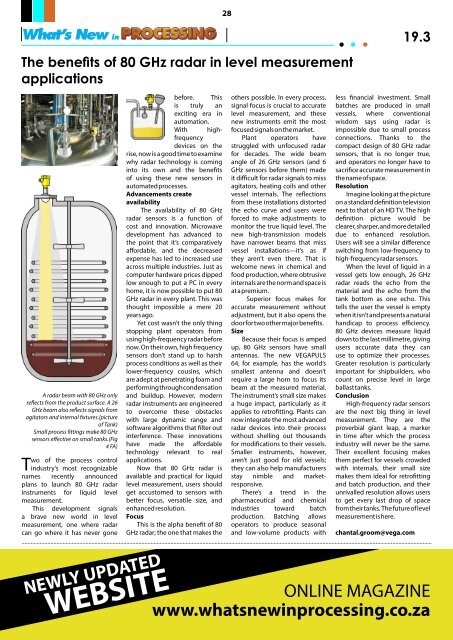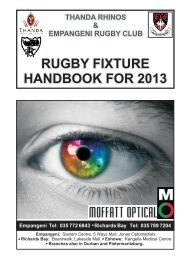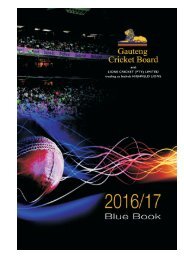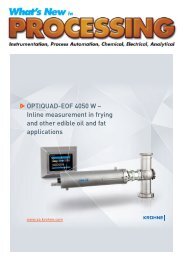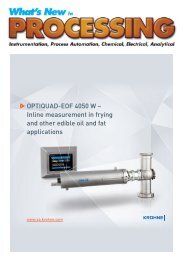WNIP May June 19.3 Digital
Wnip may june 19 3 digital
Wnip may june 19 3 digital
Create successful ePaper yourself
Turn your PDF publications into a flip-book with our unique Google optimized e-Paper software.
28<br />
<strong>19.3</strong><br />
The benefits of 80 GHz radar in level measurement<br />
applications<br />
A radar beam with 80 GHz only<br />
reflects from the product surface. A 26<br />
GHz beam also reflects signals from<br />
agitators and internal fixtures.(picture<br />
of Tank)<br />
Small process fittings make 80 GHz<br />
sensors effective on small tanks.(Fig<br />
4 FA)<br />
Two of the process control<br />
industry’s most recognizable<br />
names recently announced<br />
plans to launch 80 GHz radar<br />
instruments for liquid level<br />
measurement.<br />
This development signals<br />
a brave new world in level<br />
measurement, one where radar<br />
can go where it has never gone<br />
before. This<br />
is truly an<br />
exciting era in<br />
automation.<br />
With highfrequency<br />
devices on the<br />
rise, now is a good time to examine<br />
why radar technology is coming<br />
into its own and the benefits<br />
of using these new sensors in<br />
automated processes.<br />
Advancements create<br />
availability<br />
The availability of 80 GHz<br />
radar sensors is a function of<br />
cost and innovation. Microwave<br />
development has advanced to<br />
the point that it’s comparatively<br />
affordable, and the decreased<br />
expense has led to increased use<br />
across multiple industries. Just as<br />
computer hardware prices dipped<br />
low enough to put a PC in every<br />
home, it is now possible to put 80<br />
GHz radar in every plant. This was<br />
thought impossible a mere 20<br />
years ago.<br />
Yet cost wasn’t the only thing<br />
stopping plant operators from<br />
using high-frequency radar before<br />
now. On their own, high frequency<br />
sensors don’t stand up to harsh<br />
process conditions as well as their<br />
lower-frequency cousins, which<br />
are adept at penetrating foam and<br />
performing through condensation<br />
and buildup. However, modern<br />
radar instruments are engineered<br />
to overcome these obstacles<br />
with large dynamic range and<br />
software algorithms that filter out<br />
interference. These innovations<br />
have made the affordable<br />
technology relevant to real<br />
applications.<br />
Now that 80 GHz radar is<br />
available and practical for liquid<br />
level measurement, users should<br />
get accustomed to sensors with<br />
better focus, versatile size, and<br />
enhanced resolution.<br />
Focus<br />
This is the alpha benefit of 80<br />
GHz radar; the one that makes the<br />
others possible. In every process,<br />
signal focus is crucial to accurate<br />
level measurement, and these<br />
new instruments emit the most<br />
focused signals on the market.<br />
Plant operators have<br />
struggled with unfocused radar<br />
for decades. The wide beam<br />
angle of 26 GHz sensors (and 6<br />
GHz sensors before them) made<br />
it difficult for radar signals to miss<br />
agitators, heating coils and other<br />
vessel internals. The reflections<br />
from these installations distorted<br />
the echo curve and users were<br />
forced to make adjustments to<br />
monitor the true liquid level. The<br />
new high-transmission models<br />
have narrower beams that miss<br />
vessel installations—it’s as if<br />
they aren’t even there. That is<br />
welcome news in chemical and<br />
food production, where obtrusive<br />
internals are the norm and space is<br />
at a premium.<br />
Superior focus makes for<br />
accurate measurement without<br />
adjustment, but it also opens the<br />
door for two other major benefits.<br />
Size<br />
Because their focus is amped<br />
up, 80 GHz sensors have small<br />
antennas. The new VEGAPULS<br />
64, for example, has the world’s<br />
smallest antenna and doesn’t<br />
require a large horn to focus its<br />
beam at the measured material.<br />
The instrument’s small size makes<br />
a huge impact, particularly as it<br />
applies to retrofitting. Plants can<br />
now integrate the most advanced<br />
radar devices into their process<br />
without shelling out thousands<br />
for modifications to their vessels.<br />
Smaller instruments, however,<br />
aren’t just good for old vessels;<br />
they can also help manufacturers<br />
stay nimble and marketresponsive.<br />
There’s a trend in the<br />
pharmaceutical and chemical<br />
industries toward batch<br />
production. Batching allows<br />
operators to produce seasonal<br />
and low-volume products with<br />
less financial investment. Small<br />
batches are produced in small<br />
vessels, where conventional<br />
wisdom says using radar is<br />
impossible due to small process<br />
connections. Thanks to the<br />
compact design of 80 GHz radar<br />
sensors, that is no longer true,<br />
and operators no longer have to<br />
sacrifice accurate measurement in<br />
the name of space.<br />
Resolution<br />
Imagine looking at the picture<br />
on a standard definition television<br />
next to that of an HD TV. The high<br />
definition picture would be<br />
clearer, sharper, and more detailed<br />
due to enhanced resolution.<br />
Users will see a similar difference<br />
switching from low-frequency to<br />
high-frequency radar sensors.<br />
When the level of liquid in a<br />
vessel gets low enough, 26 GHz<br />
radar reads the echo from the<br />
material and the echo from the<br />
tank bottom as one echo. This<br />
tells the user the vessel is empty<br />
when it isn’t and presents a natural<br />
handicap to process efficiency.<br />
80 GHz devices measure liquid<br />
down to the last millimetre, giving<br />
users accurate data they can<br />
use to optimize their processes.<br />
Greater resolution is particularly<br />
important for shipbuilders, who<br />
count on precise level in large<br />
ballast tanks.<br />
Conclusion<br />
High-frequency radar sensors<br />
are the next big thing in level<br />
measurement. They are the<br />
proverbial giant leap, a marker<br />
in time after which the process<br />
industry will never be the same.<br />
Their excellent focusing makes<br />
them perfect for vessels crowded<br />
with internals, their small size<br />
makes them ideal for retrofitting<br />
and batch production, and their<br />
unrivalled resolution allows users<br />
to get every last drop of space<br />
from their tanks. The future of level<br />
measurement is here.<br />
chantal.groom@vega.com<br />
NEWLY UPDATED<br />
WEBSITE<br />
ONLINE MAGAZINE<br />
www.whatsnewinprocessing.co.za


